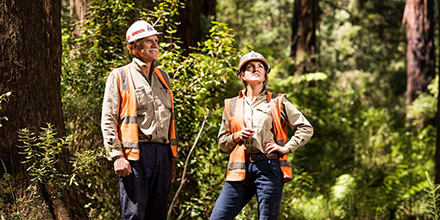
VicForests has launched a radical policy on native forest operations that involves revised harvesting and regeneration techniques as part of its campaign to achieve FSC certification. The policy centres on preserving “high conservation value” (HCV) native forest and removing perceived threats to native fauna by retaining habitat trees, large trees, banning all old growth forest harvesting, and progressively reducing its reliance on clear-felling and regeneration burning through variable retention systems. It is expected to have a big impact on the forestry industry in Gippsland and the North East. Source: Philip Hopkins for Timberbiz
Specifically, VicForests is introducing these changes to achieve the FSC Controlled Wood Standard, an interim measure to achieve full FSC certification. VicForests already has PEFC certification, which is the largest certification system in the world.
Major retailers such as Bunnings and Officeworks have said they will only accept FSC products from next year. Green groups have been campaigning for the change.
The new policy was outlined last week by VicForests manager of biodiversity and resources, Tim McBride, who has been the FSC project manager since last October. He opened his presentation by pointing out that VicForests now harvests about 2500-3000 hectares per year, which is less than 0.4% of the 7.1 million ha native forest estate. About 94% of this forest is protected in parks and reserves.
Mr McBride said the forest would be managed for multiple forest values, driven by conservation and protection at the landscape and local coupe scale. Under the FSC controlled wood standard, there were five categories of unacceptable material, he said.
These included illegally harvested wood, wood harvested in violation of traditional and civil rights, wood from areas where high conservation values are threatened, wood harvested in forests being converted to plantations of non-forest use, and wood from forests with genetically modified trees.
Mr McBride said VicForests had been acting to meet the recommendations of a 2017 FSC audit, which included a revised strategy to engage a large cross-section of stakeholders, including groups critical of VicForests. With a new audit to start in November, the roadmap now was to have the process wrapped up by mid-next year.
“The focus is on a high level of retention where possible…We are adapting harvest and regeneration systems to address site specific characteristics at a landscape and coupe level scale,” he said.
“The focus is on early planning of the harvest and regeneration system, incorporating HCV protection in harvest and regeneration systems through all forest types.” With sophisticated mapping, harvest machine operators would know where the HCV are and organise operations to ensure they were protected, he said. The dynamic document would change monthly or yearly from new data on conservation values coming from the community, research groups and the Government.
Mr McBride said the focus would be on tree retention in harvesting areas, incorporating protection for existing hollow-bearing trees because these were critical for habitat. Future habitat trees would also be retained and mapped, with biodiversity corridors and aggregated retention across the broader forest landscape, he said.
The use of variable retention systems meant a reduced burning to prepare coupes for regrowth and regeneration.
“VicForests is also listening and responding to …views and concerns about clear-felling and high intensity burns for regeneration of Ash forests,” he said.
Queried on whether the new approach would lower harvest volumes, a VicForests spokeswoman said variable retention harvesting was planned in parallel with the need to sustainably and commercially manage wood volumes.
“We anticipate wood volumes will be maintained at levels that allow us to meet demand now and what may be contracted in the future,” she said. “Our landscape-wide planning enhances VicForests’ ability to manage the forests and timber supply. It allows us to identify over the long-term necessary forest protection measures and timber supply at a regional scale rather than by a couple-by-coupe basis.”
The spokeswoman said regeneration of harvested coupes was now being done using mechanical disturbance techniques and low intensity burning. “We will undertake ongoing monitoring of regeneration. While mechanical disturbance techniques are more expensive, early planning can mitigate the increased cost,” she said.
Narracan MP Gary Blackwood, who is the Opposition spokesman on forestry, said VicForests had been forced to make extraordinary concessions to achieve FSC accreditation – a result of the boundless demands of the “job-destroying Greens”.
“The impact on access to the resource for the native forest industry is once again going to be profound and cost jobs, and hit already struggling communities,” he said. “Add to this the deliberate and calculated undermining of the industry by the Andrews Government as they continue to use flawed science, to justify managing threatened species on an individual basis rather than a landscape regime.”






